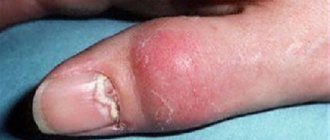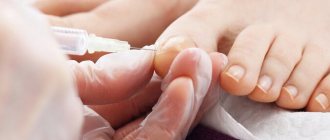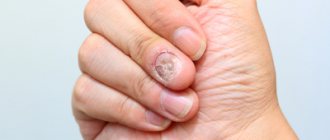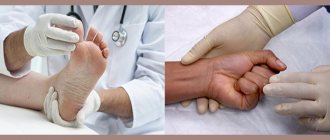Fungus is an infectious disease that affects the skin of the feet. The causative agents of the infection are parasitic fungi that provoke peeling, thickening, layering of scales and other structural changes in the skin. When scratching lesions, there is a risk of secondary infections, especially when it comes to the legs. Heel fungus is treated with local or systemic antifungal drugs. They improve the condition of tissues and destroy pathogens. Untimely treatment of the disease is fraught with the spread (generalization) of infection and damage to the entire body.
Why does fungus appear?
Mycosis of the heels is an infectious skin lesion on the back of the foot, which is caused by parasitic fungi:
- microsporum;
- trichophyton;
- candida;
- epidermophyton.
People of certain professions are susceptible to mycosis of the heels - athletes, workers in hot shops, military personnel, miners.
Infection occurs through contact with sick people or the use of objects contaminated with spores. According to statistics, in 60-80% of cases, mycosis of the heels is caused by Trichophyton rubrum (red trichophyton). The entry points for infection are:
- cracks;
- abrasions;
- ulcerations;
- cuts.
Infection occurs when the immune defense is critically reduced. In dermatology, there are many factors that provoke heel fungus:
- lack of personal hygiene;
- circulatory disorders in the lower extremities;
- irrational use of cytostatics and antibiotics;
- skin injuries on the legs;
- sedentary work;
- atherosclerosis of peripheral vessels;
- abuse of hormonal contraceptives;
- obliterating endarteritis (narrowing of the arteries of the legs);
- vitamin and mineral deficiency;
- varicose veins;
- psycho-emotional stress;
- wearing tight shoes and synthetic socks;
- excessive sweating (hyperhidrosis);
- unbalanced diet;
- bad habits;
- vegetative-vascular dystonia;
- diabetes.
The risk group includes people suffering from flat feet, HIV infection, and endocrine pathologies.
The likelihood of infection increases when visiting public baths, locker rooms, and swimming pools without personal rubber slippers. Mycosis is detected mainly in adults, and 3 times more often in residents of large cities.
Causes
Heel fungus is a common form of dermatomycosis, which is provoked by pathogenic microorganisms. The skin contains many opportunistic fungi, but most often they are in a latent state. Their activation occurs against the background of a violation of the barrier function of the epidermis and a decrease in general immunity.
The following factors can provoke mycosis on the heels:
- increased sweating of the feet;
- thyroid dysfunction;
- diabetes;
- mechanical damage (scratches, abrasions);
- overweight;
- changes in the chemical composition of sweat;
- wearing closed shoes in the warm season;
- phlebeurysm;
- vitamin deficiency;
- abuse of hormonal ointments;
- orthopedic diseases;
- lack of personal hygiene;
- secondary immunodeficiencies;
- long-term use of antibacterial drugs.
Infection occurs through contact and household contact when using other people's hygiene items, shoes, socks. Shower rugs and bathhouse benches contaminated with fungal spores can also become a source of dermatomycosis. In most cases, infection occurs in public places and at home through contact with sick family members.
What fungus looks like on the heels: signs and forms
Cracks in the heels, unpleasant odor, thickening and flaking of the skin are obvious symptoms of a fungal infection on the back of the foot. The severity of the clinical picture depends on the type of pathogen and the nature of the course of mycosis. Indicates foot fungus:
- pronounced skin pattern;
- peeling;
- redness;
- blistering rash;
- moderate to severe itching.
In clinical dermatology, there are several forms of heel fungus:
- Squamous is the mildest form of the fungus, in which the infection penetrates the surface layers of the skin. It manifests itself as itching and peeling of the feet, blistering rashes of a pale gray hue. A border of peeling skin is formed at the periphery of the lesions.
- Hyperkeratotic – characterized by severe thickening and roughening of the skin. Due to the decrease in elasticity, it cracks, which leads to the formation of deep cracks.
- Intertriginous is a common form of mycosis, in which the interdigital spaces are first affected. Over time, the fungus spreads to the entire foot. Sometimes it moves to the flexor surfaces. It manifests itself as weeping, severe itching, erosions and cracks.
- Dyshidrotic is a vesicular form of the fungus, in which multi-chamber vesicles form on the skin. Most often, the interdigital folds, skin of the soles and arches of the foot are affected. Over time, the bubbles open, and in their place erosions of a bright red hue form.
Different forms of mycosis of the heels can transform into one another or be combined.
If left untreated, self-infection occurs. Over time, the fungus spreads to the interdigital area, dorsum of the foot, and shin. In case of chronic fungal infection, the nails are affected (onychomycosis).
What is the danger of the disease
Heel fungus progresses quickly in children and adults with weak immune systems. Incorrect or absent treatment leads to the spread of infection, damage to the skin of the limbs and torso. Erosion and cracks in the heels increase the risk of streptococcal infection, which is fraught with the following complications:
- thrombophlebitis;
- lymphangitis;
- erysipelas;
- lymphadenitis;
- streptoderma.
In patients with rubromycosis, erosions occur in the heel area, prone to peripheral growth. Externally, the disease is similar to erythema nodosum or vasculitis.
Symptoms of fungal infections
The nature and severity of pathological changes depend on the virulence (pathogenicity) and type of pathogen, as well as on the reactivity of the body, the area of localization and the area of the lesion. Signs of the disease cannot be identified independently. When primary symptoms appear, it is recommended to consult a doctor rather than begin self-medication.
The main symptoms of fungus in children:
- Body and scalp. Accompanied by redness, peeling and baldness (hair is broken off at a height of 4-5 mm), as well as the appearance of grayish-white scales.
- Feet, hands and interdigital space. Toenail fungus in children is characterized by excessive dryness, redness, moderate weeping and peeling. There are also bubbles and cracks that itch unbearably.
- Mucous membranes of the oral cavity and genitals. Thrush or candidiasis is accompanied by the appearance of a white, cheesy coating. Extensive superficial ulcerations and vesicular rashes are accompanied by burning and itching.
None of the known fungal diseases develops lasting immunity, so repeated infections are not excluded. That is why parents should know what fungus looks like in children and consult a doctor when the first symptoms appear.
Diagnostics
Fungal diseases are diagnosed by a dermatologist or mycologist. If the skin of the heels thickens and cracks, the doctor prescribes a comprehensive diagnosis:
- Dermatoscopy is the examination of affected areas of the skin under multiple magnification of a dermatoscope. It is used to assess structural changes in the epidermis in lesions.
- Luminescent examination - diagnosis of mycoses using a Wood's lamp. The procedure is performed in a dark room. A greenish glow in the skin of the heels indicates a fungus.
- Skin scraping microscopy is a laboratory analysis of tissue samples. A mycotic infection is indicated by the presence of fragments of mycelium and fungal seeds in the scraping.
- Sowing scrapings onto nutrient media is the cultivation of pathogenic microorganisms, during which the causative agent of the infection is determined.
Based on the results of a comprehensive diagnosis, the mycologist determines the form of fungal infection of the feet - candidiasis, rubromycosis, athlete's foot.
Depending on the cause of heel damage, the patient may require additional consultation with a vascular surgeon, endocrinologist, orthopedist, or podiatrist.
Reasons for the development of mycosis
Predisposing factors include taking antibiotics, poor hygiene when visiting swimming pools, increased sweating and/or poor immune system protection. In most cases, pathological disorders in the body occur due to a combination of reasons.
Varieties of opportunistic microorganisms that are causative agents of the disease:
- yeast (Candida albicans causes thrush);
- dermatophytes (provokes herpes zoster);
- mold (causative agent of aspergillosis and respiratory tract problems).
The most common is Candida albicans - it is part of the natural microflora, present in 50% of the population. It does not cause problems until it begins to multiply uncontrollably under the influence of certain factors. Most often, Candida passes from mother to baby during childbirth and breastfeeding.
How and what to treat fungus on the heels
The fungal infection is destroyed by local and systemic antimycotic agents. The former kill the fungus in the affected areas, and the latter - throughout the body. The course of therapy is compiled taking into account:
- pathogen;
- the extent of the lesions;
- complications.
Typically, drug treatment for mycosis of the heels takes no more than 3 months. If the fungus affects the nails, therapy is extended for another 3-4 months. To assess the effectiveness of treatment, a repeat luminescent study is performed.
Local treatment
External treatment of heel fungus is carried out with antifungal creams, ointments and gels. The dermatologist prescribes products based on clotrimazole, ciclopirox, naftifine, terbinafine:
- Imazol;
- Fungisan;
- Terbizil;
- Exoderil;
- Kandisan;
- Batrafen;
- Candide;
- Exic.
To quickly cure a fungal disease, therapy includes ointments and creams with different pharmacological properties:
- anti-inflammatory (Arnica, Efkamon) - reduce inflammation, prevent erosive damage to the skin of the heels;
- analgesics (Anestezin, Benzocaine) – eliminate pain;
- corticosteroids (Lorinden S, Betasalik) – eliminate itching, which prevents scratching;
- keratolytic (Lorinden A, Bensalitin) – exfoliate dead cells, prevent thickening and cracking of the heels;
- antiseptic (Miramistin, BoroAyur) – destroy pathogenic flora, prevent secondary infections;
- improving blood microcirculation (Solcoseryl, Actovegin) - prevent blood stagnation, stimulate local immunity;
- healing (Wundehil, Panthenol) - accelerate skin regeneration in lesions.
Hormonal ointments are not used for weeping or erosive heels.
During the entire treatment period, it is recommended to treat closed shoes with antiseptics - Octenisept, Chlorhexidine, Miramistin - at least 1-2 times a week. After recovery, it is better to throw away the shoes in order to prevent recurrence of the fungus.
Pills
Systemic treatment of heel fungus is carried out when local therapy is ineffective. To destroy the infection, medications are prescribed based on the following active ingredients:
- ketoconazole – Dermazole, Nizoral, Apo-ketoconazole;
- fluconazole – Medoflucon, Kandizol, Diaflu, Diflucan;
- terbinafine – Binafin, Terbizil, Mycofin, Atifan, Terbinox;
- itraconazole - Iconazole, Mycostop, Orungal, Izol, Trioxal.
Tablet remedies for fungus are taken in courses of 1 week. For lesions of the heels, interdigital area and nails, Griseofulvin, a fungistatic antibiotic, is recommended. Its components accumulate in the cells of nails, hair and skin, which leads to the destruction of infection.
Hardware methods
To quickly get rid of heel fungus, they resort to physiotherapeutic procedures. Their action is aimed at:
- acceleration of blood circulation in the extremities;
- pain relief;
- healing of erosions;
- strengthening local immunity.
Depending on the indications, UV therapy and laser therapy are prescribed. Particular attention is paid to caring for the skin of the feet. If heels and nails are affected, a medical pedicure is recommended, which is performed in several stages:
- feet are disinfected with a solution of antiseptic;
- feet are steamed in a bath of decoction of medicinal herbs;
- Calluses and keratinized skin are removed with a special milling cutter;
- use an abrasive attachment to clean off the top layer of nails;
- heels and nail plates are treated with antifungal ointment.
For dermato- and onychomycosis, therapeutic pedicures are done up to 2 times a week. It prevents thickening and cracking of the heels.
Traditional medicine
Herbal medicine, which can be carried out at home, is effective in the fight against fungus. To soften the skin on the heels and heal wounds, baths, applications, tonics, compresses, and lotions are used.
Effective remedies for mycosis of the heels:
- Herbal bath. Mix 2 tbsp. l. chamomile, St. John's wort and calendula. Pour in 3 liters of water and boil over low heat for 3-5 minutes. The feet are immersed in a filtered warm broth for 20-25 minutes. Take baths up to 3 times a day.
- Onion lotions. Large onions are passed through a meat grinder. Wrap the pulp in gauze and keep it on the skin of the heels for 10-15 minutes. Perform the procedure up to 3-4 times a day.
- Compress. 1 tbsp. l. Boil chopped calamus root in 250 ml of water for 4 minutes. Add 3-4 drops of eucalyptus oil. Soak a cotton-gauze bandage in the broth and apply to the heels for half an hour up to 4 times a day.
- Applications with soap. A piece of laundry soap is ground on a grater. 3 tbsp. l. The shavings are mixed with warm mineral water until a creamy mass is obtained. Add 7-10 drops of tea tree oil. Treat the affected areas with the mixture. After 15-20 minutes, wash off with warm water.
- Foot toner. Dilute ½ tsp in 30 ml of mineral water. garlic juice and medical alcohol. Soak a cotton pad in the solution and wipe the heels, feet and interdigital area with it three times a day.
Tea tree oil is ideal for disinfecting and softening the skin. They treat heels before going outside.
Prevention
Preventive measures are aimed at strengthening the immune system and eliminating factors that provoke the proliferation of the fungus. To prevent mycosis of the heels you need to:
- maintain personal hygiene;
- disinfect closed shoes with antiseptics;
- use personal hygiene products;
- promptly treat skin infections;
- give up synthetic socks in favor of cotton ones;
- eat a balanced diet;
- use rubber slippers when visiting public baths;
- take vitamin and mineral complexes twice a year;
- treat the interdigital area with antifungal powders.
With weak immunity and endocrine disorders, the risk of infection with a fungus increases by 2-3 times. For such diseases, you need to be examined by a dermatologist twice a year. Timely detection and treatment of mycosis of the heels reduces the likelihood of complications - streptoderma, thrombophlebitis.
Why does heel fungus occur?
Different types of pathogenic fungi can cause the disease (there are about 50 varieties). A fungal infection can affect the heels in the following cases:
- when wearing someone else's socks, shoes, using towels, bed linen;
- as a result of visiting a sauna, bathhouse, swimming pool (without using rubber slippers);
- with insufficient foot care;
- after surgery;
- when the protective functions of the skin and the body as a whole are weakened;
- as a result of wearing wet shoes, socks;
- after microbes penetrate into cracked heels;
- when you receive a foot injury.











